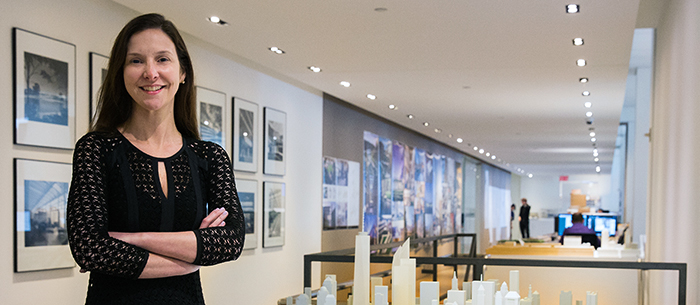Rising to new heights is nothing new for Nicole Dosso, AIA, LEED APBD+C, who is known for building the tallest tower in the United States, One World Trade Center. However, Dosso, a technical director at the New York office of Skidmore, Owings & Merrill (SOM), is the first to tell you that she didn’t do it alone and had to overcome many challenges to accomplish her professional goals.
We recently caught up with Dosso on her visit to the NCARB office to take part in a webinar about women in architecture. She provided some encouragement and useful advice for rising architects, along with insights about her own path to success.
Breaking the Glass Ceiling
“I do feel a sense of pride, having been involved in the One World Trade Center project, and I think it was good for women in general,” Dosso said.
As a Syracuse University graduate now looking back on her career, Dosso, 40, admits that she only had a limited number of female peers in the early days. “Today, I’m not sitting at the table by myself, as a woman, which I think is great.”
Know What You Want
Dosso urges aspiring architects to know what they want to do and take control of their own careers. “I think some of that is a navigating process,” she said. “You can’t just sit dormant waiting for something to happen for you. You have [to] put yourself out there and try to make those things happen.”
The Importance of Licensure
SOM places a great deal of emphasis on licensure for new employees, as does Dosso. The company supports licensure by providing time off for the ARE, paying for books and study tools, and linking employees with mentors. Dosso considers it a major recruiting tool.
“I recommend everyone get licensed. It’s so important. I can’t emphasize it enough. Ultimately it is the culmination of your degree. It’s not about the firm you work for, it’s ultimately for yourself.”
Stick With It
Success in architecture didn’t always come easy for Dosso. She admits to having a rough beginning at Syracuse. She made many calls home to get advice from her father, a construction professional with some tough-love advice: “Finish what you start.”
“I got this huge box full of tools on my first day of architecture school and I had never seen any of this stuff before,” Dosso said. “I didn’t know what a Mayline was. I didn’t know what an adjustable triangle was. So I really struggled my first semester trying to figure out what I was doing here and why I had selected architecture.”
Learning from Mistakes
Ironically, Dosso failed her technical design course at Syracuse. She tells the story of going to the professor and asking him to change her grade. The professor was willing, but asked her why she had not once visited him during office hours when she knew she was struggling. He challenged her: “Do you really want to become an architect?”
“I took the F and repeated the course,” Dosso said. “I often think about that when I look back. What if I had taken the easy path? Sometimes, you have to have hard lessons in life to succeed.”
The Power of Mentorship
“I mentor a lot of people,” Dosso said. “I get a lot of satisfaction in it. I think because I had so many great mentors, I feel like it’s really important to give back.” She urges emerging architects to work on cultivating professional relationships, being prepared for work, and listening intently to feedback. Mentors will arise out of such experiences.
“Be willing to listen to what people have to say, then take their advice and make good of it. Mentors can take on many different forms. It doesn’t necessarily have to be a person in your life daily. It can just be a conversation that can change your perspective.”
Delayed Gratification
Major professional accomplishments for architects are often slow to come, Dosso notes. It was a full decade after graduation that Dosso said she saw the first fruits of her labor at SOM—the opening of 7 World Trade Center. “That was really my first moment of professional satisfaction.”
Her hard work paid off. The satisfaction she got to help build “Tower Seven” and other tall building projects like it was soon eclipsed by the rise of One World Trade Center.
“The first milestone was getting to grade,” Dosso said. “Below ground was complicated. “Eventually, they lifted the last piece of steel, I walked into the building, and people were buzzing all around. That was very fulfilling.”
